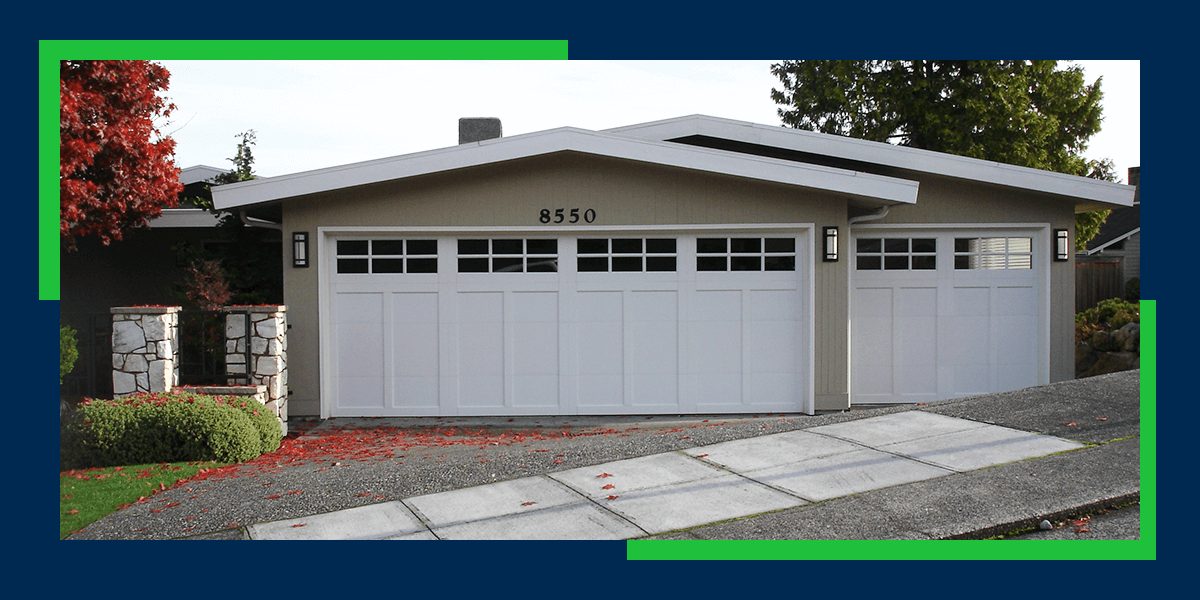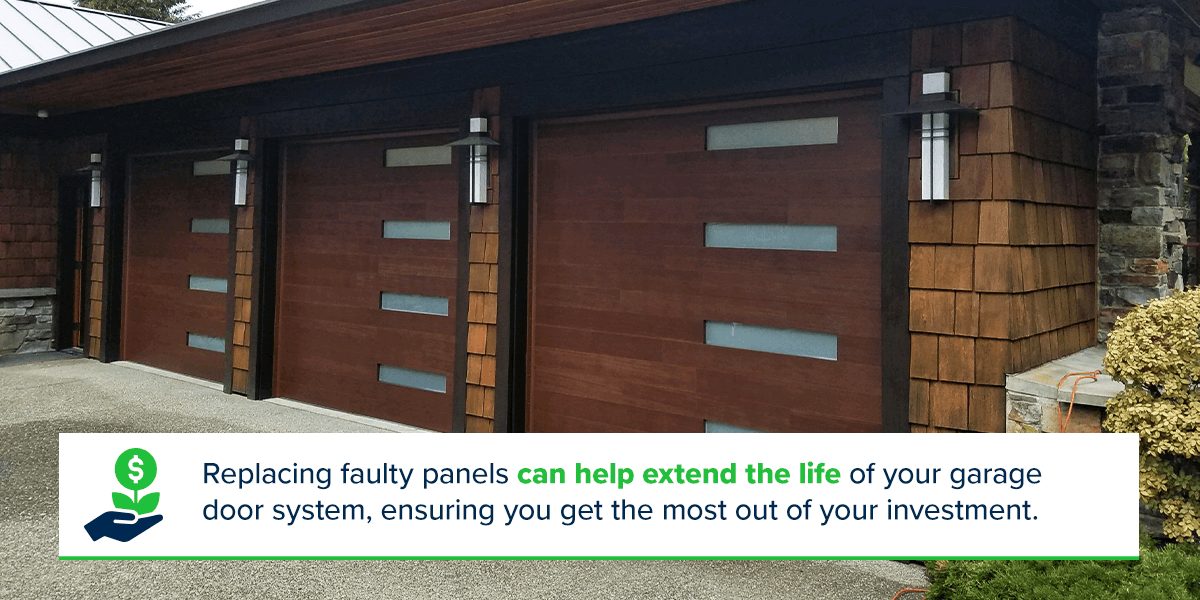Updated 10/7/2024
Garage door panels are important to your door’s aesthetics, safety and functionality. They can prevent the rest of the system from properly operating when they become damaged.
Below, we’ll cover how to replace garage door panels with professional assistance to ensure the longevity and safety of your garage door.
Things to Know in This Article:
What to Know About Replacing Garage Door Panels
Before starting your garage door panel replacement, review these frequently asked questions to prepare.
Can You Replace Individual Garage Door Panels?
Yes, replacing a single panel at a time is usually possible. Replacement eligibility will depend on the type of garage door you have and whether the manufacturer makes a panel style that is compatible with your existing door.
Damage severity will also affect whether a professional can repair the panel or not. Minor damage to one or two panels can be repaired, while extensive damage to three or more panels likely requires an entire garage door replacement.
How Do You Know When to Replace a Garage Door Panel?
Damage to your residential garage door can happen in an instant, and it can happen slowly over time. Some common causes include:
- Accidental vehicle impacts that dent or crack panels, leading to misalignment.
- Weather exposure, which can cause rust, warping and deterioration.
- General wear and tear that leads to sagging, inefficient operation, gaps between panels or unusual noises.
If you notice damage to a garage door panel, you will most likely need to replace it to ensure the safety and functionality of your system. Dents and dings may seem minor but can affect the garage door’s structural integrity if left unrepaired. A professional can also help you assess the damage and determine what repairs are needed.
How Can You Buy Replacement Panels for Garage Doors?
Once you’ve contacted a reputable garage door repair company, you’ll be able to purchase the materials you need and schedule a time to get your repairs. DistribuDoors offers panel repair service to new and existing customers in our service area, even if we didn’t install your doors.
When you contact us, we will ask you to provide the following information:
- Brand/model information
- Photos of inside and outside of garage door (can be emailed or texted to the office)
- Measurements (width first, then height)
Major brands that we carry include Clopay®, Northwest Door, Amarr and Wayne Dalton.
DIY Garage Door Panel Replacement vs. Hiring a Professional
While you can buy the garage door panels yourself, you should not attempt a DIY installation. The replacement process is complex and full of safety risks. Springs cause tension in the panels, which are also very heavy. An inexperienced person could get injured trying to do the replacement by themselves. They could also cause permanent damage to the garage door.
Rather than risking injury and property damage, reach out to a repair service company right away to install your new panel. Professionals have the knowledge, experience and tools to replace garage door panels safely and efficiently. They will repair your door effectively to minimize the risk of future issues and maximize the life span of your system.
What Do You Need to Replace a Garage Door Panel?
To replace a single garage door panel, you’ll need to know several things about your door, including:
- Dimensions of the panel
- Model
- Exact color
- Which section is damaged, such as the bottom, middle or top
Look for the serial number on the back or side of your door, then contact the manufacturer to request information about your garage door model. If you purchased your doors from DistribuDoors, contact our office, and we can look this information up.
Steps to Replacing Garage Door Panels
Check out these five steps to prepare for the garage door panel replacement process:
1. Close the Garage Door Safely
The first step whenever your garage door is damaged is to safely close it and keep it closed. Do not continue to operate the door, as it may cause more damage. If the door does not close, reach out to a garage door technician to come out and close it for you.
2. Inspect the Door
Look over your garage door and take note of any issues you see. Check the severity of the damage and determine how many panels need to be replaced. Write this information down so you can share it with your garage door specialist.
3. Collect the Brand and Model Information
Once your door is safely closed, search the inside for any brand or model information. Write down the information you find, or simply take a photo. If the stickers have fallen off or have been worn off, you can take a photo of the inside and outside of the garage door. Make sure the whole door is in the photo. Experienced garage door technicians may be able to tell you the brand and model information just by seeing the pictures.
4. Measure the Width and Height of the Panel
Next, get a tape measure and measure the full width of your door and the height of the section needed. Write it down. Garage doors are measured by width first (e.g., W 16’ x H 21”).
5. Contact a Garage Door Repair Specialist
Once you have all your information, photos and measurements, contact your local garage door company. Give them all of your gathered information. They should be able to give you pricing over the phone or email to get your replacement on order as quickly as possible. Some basic garage door designs may be available immediately, while others will need to be ordered.
If you are unable to gather all of this info yourself, simply let your garage door dealer know that you will need someone to come out to get the information and provide pricing. Schedule an appointment, and the garage door technician can determine the repairs you need after the inspection.
Should You Repair the Panels or Replace the Garage Door?
Repairing panels can be cost-effective when only one or two panels have minor damage. If you have a newer garage door, replacing these faulty panels can help extend the life of your garage door system, ensuring you get the most out of your investment.
In some instances, replacing the entire garage door is the safer and more financially beneficial option.
You may need to replace your garage door if:
- The door is old: If the damage on a panel is due to age, the entire door will likely suffer the same issues within a short period. You can save money by replacing the door rather than repairing one panel at a time. Outdated models may also lack modern safety features, increasing risk. It is better to upgrade your door to protect your loved ones and property.
- Three or more panels are damaged: If you have several panels that need to be replaced, buying a new door is a better long-term solution. Depending on the brand and model you have, installing a new garage door with brand-new hardware can cost about the same as replacing three sections of an existing garage door. Extensive panel damage can also cause structural and mechanical problems as time goes on. Replacing the entire door can ensure safety and functionality.
- The garage door has structural issues: Sometimes panels break due to structural problems, such as a sagging door frame. Replacing your garage door may be the only solution to fixing the root problem behind broken panels. Structural components such as springs or hardware may be worn or damaged, causing sagging panels. Sagging panels and cracked or peeling paint that remain an issue despite regular maintenance also signal the need for new doors.
Choose DistribuDoors for Residential Garage Door Replacement Panels
Do you need repairs on your garage doors? If so, DistribuDoors can help. We provide comprehensive repair services to customers throughout the greater Seattle area. Thinking you might go with replacement instead of repair? We also sell Clopay® garage doors with the Good Housekeeping Seal of Approval. We’ll better any competitors’ deals submitted in writing by five percent, so contact us today to request repair service or get a free installation estimate on new doors.



